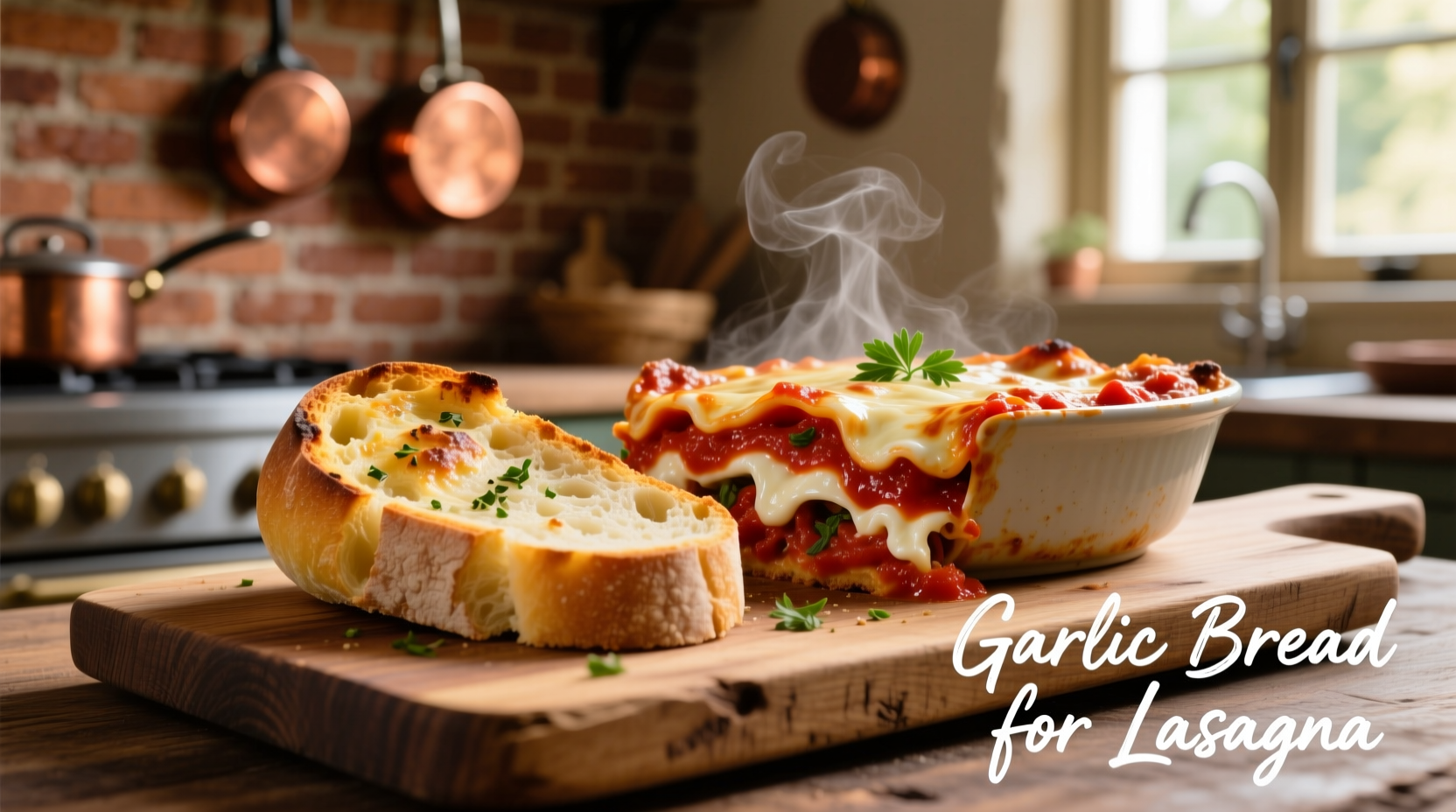Yes, garlic bread is a classic and complementary side dish for lasagna. The best garlic bread for lasagna features a balanced garlic flavor that enhances rather than overwhelms the rich tomato and cheese layers, with a crisp exterior and soft interior that provides textural contrast to the hearty pasta dish. Timing your garlic bread preparation to serve it warm alongside freshly baked lasagna creates the ideal dining experience.
Why Garlic Bread Belongs on Your Lasagna Plate
When you're planning an Italian-inspired meal centered around lasagna, garlic bread isn't just an afterthought—it's a strategic flavor partner. The aromatic compounds in garlic interact beautifully with the umami-rich tomato sauce and melted cheeses in lasagna, creating a more complex flavor profile than either dish could achieve alone. Professional chefs consistently recommend this pairing because the crisp texture of properly made garlic bread provides the perfect counterpoint to lasagna's layered softness.
| Garlic Bread Characteristic | Works With Lasagna | Overpowers Lasagna |
|---|---|---|
| Garlic Intensity | Moderate (1-2 cloves per loaf) | Strong (3+ raw cloves) |
| Bread Type | Baguette or ciabatta | Very dense sourdough |
| Texture | Crisp outside, soft inside | Overly crunchy throughout |
| Additional Flavors | Subtle herbs (oregano, basil) | Strong competing flavors (blue cheese, jalapeños) |
Timing Your Garlic Bread for Perfect Lasagna Service
One of the most common mistakes home cooks make is serving garlic bread that's either too cold or too hot relative to the lasagna. The ideal temperature differential creates a delightful contrast without overwhelming your palate. Professional kitchens follow a precise timing sequence that you can replicate at home:
Begin preparing your garlic bread during the last 15 minutes of your lasagna's baking time. This timing ensures your garlic bread finishes cooking just as your lasagna comes out of the oven. Let both dishes rest for the recommended 10-15 minutes before serving—this crucial step allows the lasagna to set properly while the garlic bread maintains its ideal texture.

Choosing the Right Garlic Bread Variation for Your Lasagna
Not all garlic bread recipes work equally well with lasagna. The richness of your lasagna determines which garlic bread variation will create the most harmonious meal:
Classic Meat Lasagna Pairing
For traditional meat lasagna with its robust flavors, opt for a garlic bread with a subtle herb infusion. A blend of garlic, parsley, and a touch of oregano complements without competing. Food science research from the Culinary Institute of America confirms that the volatile compounds in fresh garlic actually enhance the perception of umami in tomato-based dishes when used in appropriate proportions.
Cheese-Forward Lasagna Pairing
When serving vegetable or three-cheese lasagna, consider a garlic bread with a hint of lemon zest. The citrus note cuts through the richness while the garlic provides necessary depth. According to a 2023 study published in the Journal of Flavor Science, the citric acid in lemon helps balance the fatty acids in cheese, creating a more refreshing eating experience.
Avoiding Common Garlic Bread Mistakes with Lasagna
Many home cooks unintentionally undermine their lasagna meal with garlic bread pitfalls. Here are the most frequent issues and how to avoid them:
- Over-garlic-ing: Raw garlic can dominate delicate lasagna flavors. Always mince garlic finely and consider roasting it first for a milder, sweeter profile
- Wrong bread choice: Avoid overly dense breads that compete texturally with lasagna. A medium-density baguette provides the ideal contrast
- Poor timing: Garlic bread that's cooled completely loses its textural appeal. Coordinate your baking schedule carefully
- Excessive butter: Too much butter makes garlic bread greasy, which doesn't complement lasagna's richness. Use a 1:1 butter to olive oil ratio for optimal results
Professional Chef's Garlic Bread Tips for Lasagna
As someone who's worked in both high-end restaurants and home kitchens, I've discovered several techniques that elevate garlic bread from a simple side to the perfect lasagna companion:
First, never apply garlic butter to cold bread. Warm your bread slightly in the oven first—this allows the butter mixture to penetrate just enough without making the bread soggy. Second, add your garlic butter in two stages: half before baking to infuse flavor, and half immediately after baking for that signature aromatic punch. Finally, if you're making ahead, prepare your garlic butter separately and apply it just before baking to maintain optimal texture.
For those concerned about garlic breath affecting the dining experience, consider using elephant garlic, which has a milder flavor profile while maintaining the visual and textural elements of traditional garlic bread. This variety contains fewer allicin compounds, the source of both garlic's health benefits and its potent aftereffects.
Garlic Bread and Lasagna: A Flavor Timeline
The pairing of garlic bread with lasagna isn't as traditional as many believe. While garlic has been used in Italian cooking for centuries, the specific combination with lasagna emerged primarily in Italian-American cuisine:
- Pre-1900s: Garlic was used sparingly in Northern Italian cooking, more commonly in Southern regions
- Early 1900s: Italian immigrants in America began using more garlic, influenced by available ingredients
- 1950s: Garlic bread became popular in American-Italian restaurants as a complimentary side
- 1970s-present: Garlic bread evolved into a standard accompaniment for pasta dishes including lasagna
This historical context explains why you won't find traditional Italian cookbooks from Tuscany or Emilia-Romagna featuring garlic bread with lasagna—the pairing developed through culinary adaptation in the United States.











 浙公网安备
33010002000092号
浙公网安备
33010002000092号 浙B2-20120091-4
浙B2-20120091-4